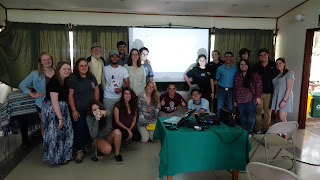La Calandria provides a very distinct habitat to those we have previously visited on this trip. The land at La Calandria was previously used mostly for coffee farming, though much of it is in various stages of new forest growth. Despite having a nearly identical elevation to the San Gerardo station, the composition of the vegetation at La Calandria is drastically different due to the differences in climate. While the San Gerardo station’s wet climate is heavily influenced by trade winds coming from the Caribbean, the station at La Calandria is located on the Pacific side of the continental divide and thus receives far less precipitation. The property is part of the Bellbird Biological Corridor and is the site of a nursery that provides the community with many species of native plants that may be used in reforestation projects.
On our first day at the station, we had the honor of accompanying don Eladio Cruz on a plant walk. Don Eladio is one of the most eminent botanists in the Monteverde area, having several species named after him. One of these, Zanthroxylum eladiumis a member of the same family as the coca plant, though he assured us that it did not have the same psychotropic properties as its better known cousin. One of the most important families of trees in this area is the Lauraceae family, which is composed of different species of aguacatillos (little avocados). The Monteverde area contains 93 species of these trees, and they play a vital role in the cloud forest ecosystem. In addition to their ecological value, they have an extremely high economic value, as they provide a primary food source for two of the region’s greatest ecotourism assets: the three-wattled bellbird and the resplendent quetzal. For these reasons, many conservation efforts (especially the Bellbird Biological Corridor) focus greatly on the reintroduction of many species of Lauraceaes, particularly those endemic to the region like Ocotea monteverdensis and Bleismedia tilaranensis. Tapping into Don Eladio’s vast reserves of knowledge, we learned a great deal about the natural histories of many types of trees in in this unique Monteverde cloud forest.
Lastly, we received a lecture from Dr. Richard LaVal, who is one of the foremost researchers of tropical bats. Our talk with him solidified many of the things we learned on our walk with Don Eladio, particularly with regards to interactions between plants and bats. We also had a chance to trap bats using a mist netting technique. Bats play an important role both as pollinators and as seed dispersers, shown by the presence of seeds in the feces of the Carollia bat caught that night. Its relationship with the Piperaceae family of trees is particularly important at La Calandria, as they play a vital role as pioneer species in the reclamation of deforested lands. Sadly, this is our last stop on our journey, but it has been a great way to bring this awesome trip to a close.


No comments:
Post a Comment